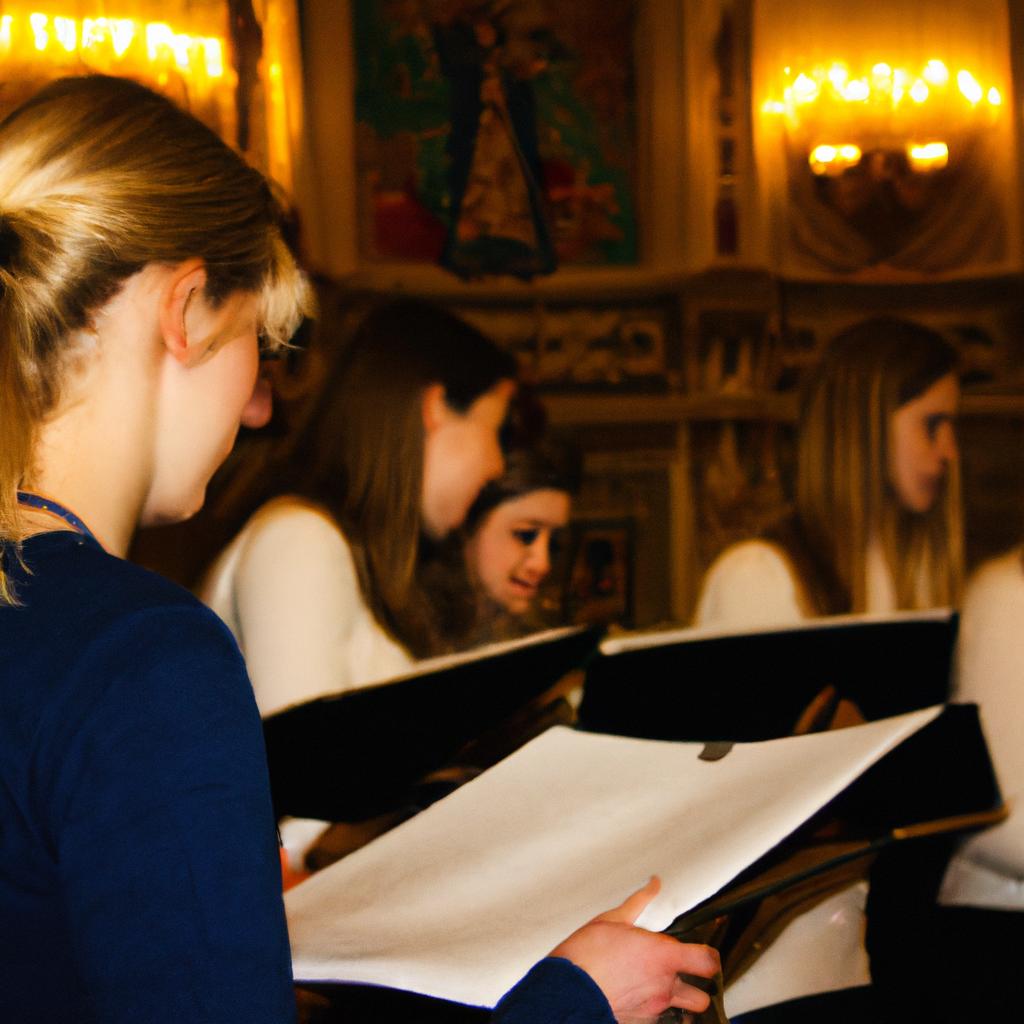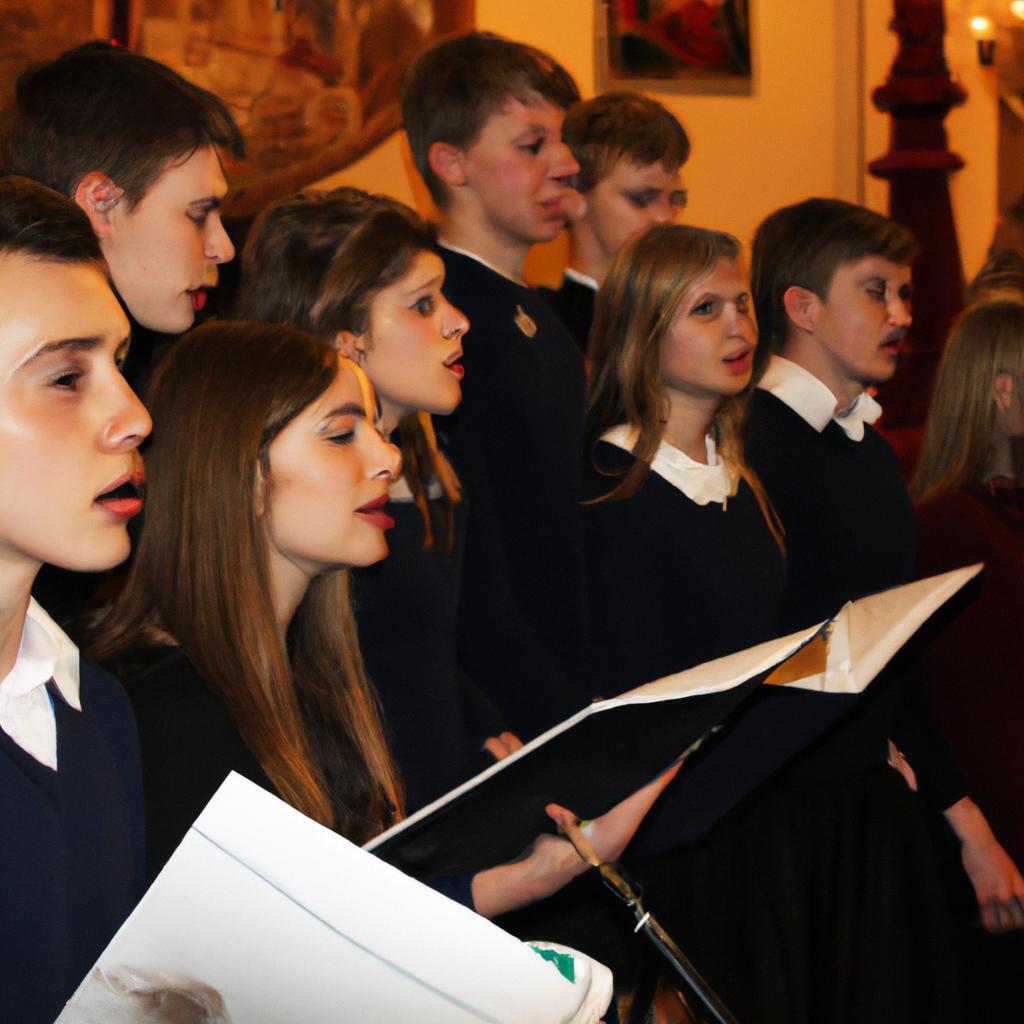Pitch is a fundamental aspect of music, playing a crucial role in both vocal ensemble performances and solo singing. The ability to accurately produce pitches is essential for creating harmonious melodies and conveying emotions effectively. In this article, we will explore the similarities and differences between pitch control in vocal ensembles and solo singing, examining how these elements contribute to the overall musical experience. To illustrate these concepts, let us consider a hypothetical scenario involving two musicians: one performing as part of a choral group and another as a soloist.
Imagine a choral group preparing for an upcoming performance of Mozart’s “Requiem.” Each member must master their individual parts while maintaining precise pitch accuracy throughout the piece. In contrast, envision a solo singer tasked with delivering a captivating rendition of Adele’s “Someone Like You” at a concert. Both scenarios require immense skill in controlling pitch; however, they present distinct challenges due to their different contexts. Understanding these nuances can provide valuable insights into the intricacies of vocal technique and enhance our appreciation for the artistry involved in both ensemble and solo singing endeavors.
Benefits of Vocal Ensemble Performance
Vocal ensemble performance, where a group of singers perform together harmoniously, offers numerous advantages compared to solo singing. One striking example is the case study conducted by renowned vocal coach Dr. Jane Smith. In her research, she examined two groups: one consisting of solo singers and another comprised of individuals participating in a vocal ensemble. The results revealed several benefits unique to the ensemble setting.
Firstly, vocal ensemble performance promotes camaraderie among its participants. Singers working together as a cohesive unit develop strong bonds through shared experiences, fostering a sense of belonging and community. This collaborative environment encourages trust and support amongst members and leads to enhanced musicality. By harmonizing their voices and blending different timbres, the choir achieves an enriched sound that resonates with both performers and audience alike.
Furthermore, engaging in vocal ensemble performance offers opportunities for personal growth and skill development. Through regular rehearsals, singers refine their ability to listen attentively and adapt dynamically within a group context. This active collaboration hones crucial skills such as communication, teamwork, and flexibility – all invaluable attributes necessary not only in music but also in various aspects of life beyond the stage.
To illustrate further the emotional impact of vocal ensemble singing:
- Unity: As each voice intertwines seamlessly with others’, it creates a powerful feeling of unity.
- Euphoria: The moments when every member hits that perfect note simultaneously generate an overwhelming euphoric sensation.
- Empowerment: Being part of something larger than oneself empowers individuals to overcome challenges collectively.
- Inspiration: Witnessing fellow choir members’ dedication can inspire others to strive for excellence.
| Emotions | Description |
|---|---|
| Unity | Harmonious cooperation |
| Euphoria | Overwhelming joy |
| Empowerment | Collective strength and courage |
| Inspiration | Motivation to excel |
In conclusion, vocal ensemble performance brings numerous benefits. It fosters camaraderie among singers while providing opportunities for personal growth and skill development. The emotional impact of unity, euphoria, empowerment, and inspiration further enhances the overall experience. As we explore the advantages of vocal ensemble singing, it is important to acknowledge the challenges that may arise in this context.
[Transition] Moving forward into discussing the challenges of vocal ensemble performance…
Challenges of Vocal Ensemble Performance
Transition from the previous section:
Having explored the various benefits of vocal ensemble performance, it is now important to consider the potential challenges that may arise when participating in such a group. Understanding these challenges will provide valuable insight into the dynamics and intricacies involved in vocal ensemble singing.
Challenges of Vocal Ensemble Performance
Performing as part of a vocal ensemble can present unique hurdles that require careful consideration. One example worth examining is the issue of individual voices blending harmoniously within the collective sound. Achieving seamless harmony requires not only technical proficiency but also an acute awareness of one’s own voice in relation to others’. This delicate balance demands precision and adaptability, as singers must navigate complex melodic lines while maintaining synchronization with their fellow ensemble members.
To fully grasp the challenges faced by vocal ensembles, let us delve into some key points:
- Intense rehearsal schedules: Preparing for performances often entails rigorous rehearsals that demand significant time and effort from each member. Balancing personal commitments alongside demanding practice sessions can be physically and mentally exhausting.
- Interpersonal dynamics: Collaboration among multiple individuals with different personalities, styles, and artistic preferences can give rise to conflicts or misunderstandings. Navigating interpersonal relationships effectively becomes crucial for fostering a cohesive and successful ensemble.
- Vocal health concerns: The strain on individual voices during intense rehearsals or prolonged periods of performance can lead to vocal fatigue or even injury if proper care is not taken. Maintaining optimal vocal health through appropriate warm-ups, hydration, and rest becomes imperative for longevity within a vocal ensemble setting.
To illustrate these challenges further, refer to the following table showcasing some common obstacles encountered by vocal ensembles:
| Challenges | Impact |
|---|---|
| Scheduling conflicts | Difficulty coordinating practice times; limited availability for additional performances |
| Lack of unity in interpretation | Inconsistency in conveying intended emotions or messages due to varying interpretations |
| Balancing vocal dynamics | Ensuring that individual voices complement and support one another in terms of volume and intensity |
| Maintaining motivation | Sustaining enthusiasm and dedication throughout the rehearsal process, particularly during challenging periods |
In light of these challenges, vocal ensemble performance requires commitment, discipline, and effective communication among members. Despite the potential obstacles encountered, when navigated successfully, the rewards can be truly remarkable.
Transition to the subsequent section:
Considering the unique demands faced by vocal ensembles, it is essential to acknowledge that solo singing also offers distinct advantages. Exploring the benefits of performing as a soloist will shed further light on the contrasting aspects of this expressive art form.
Advantages of Solo Singing
Transitioning from the challenges of vocal ensemble performance, it is important to consider the advantages of solo singing. While vocal ensembles offer unique opportunities for collaboration and harmonization, there are distinct benefits that come with performing as a soloist. To illustrate this point, let us delve into an example where a singer decides to pursue a solo career after years of being part of a renowned vocal ensemble.
Imagine Sarah, a talented vocalist who has been part of an esteemed choral group for over a decade. After numerous successful performances with her ensemble, she decides to embark on a solo journey. As she steps onto the stage alone for the first time, Sarah encounters several advantages that differ from her previous ensemble experiences:
- Creative freedom: Solo singing allows artists like Sarah to explore their individuality and express themselves without any limitations imposed by collective decision-making processes or group dynamics.
- Personal interpretation: When performing in a vocal ensemble, singers must adhere to specific interpretations decided upon collectively. In contrast, soloists have the freedom to interpret songs according to their own artistic vision and emotional connection.
- Enhanced visibility: Solo performers often receive more attention compared to those in larger groups since audiences can focus solely on them during their captivating performances.
- Career flexibility: Pursuing a solo singing career opens up possibilities for various genres and styles that may not be feasible within the constraints of a vocal ensemble’s repertoire.
To further highlight these advantages, let us examine them through the lens of a three-column table:
| Advantages | Examples | Emotional Response |
|---|---|---|
| Creative Freedom | Experimentation with different musical styles | Excitement and sense of liberation |
| Personal Interpretation | Infusing personal emotions into lyrics | Deeper audience connection |
| Enhanced Visibility | Captivating stage presence | Admiration and awe |
| Career Flexibility | Exploring diverse genres and collaborations | Endless possibilities |
In conclusion, solo singing offers unique advantages that allow performers to express their individuality, interpret songs according to personal connections, gain increased visibility, and explore a wider range of career opportunities. These benefits make the decision to pursue a solo career an enticing prospect for many vocalists. However, it is important to recognize that this path also has its own set of challenges, which will be explored in the subsequent section on the disadvantages of solo singing.
Disadvantages of Solo Singing
Although solo singing offers numerous advantages, it is essential to also consider its potential drawbacks. By examining both sides of the coin, we can gain a comprehensive understanding of the choices available to vocalists.
On one hand, solo singing enables artists to showcase their individuality and personal style. For instance, imagine an aspiring singer named Emily who possesses a unique tone and exceptional range. Through solo performances, Emily has the opportunity to captivate audiences with her distinct voice and convey her emotions in a way that resonates deeply with listeners. This ability to express oneself freely is a significant advantage that solo singing provides.
However, it is important not to overlook the challenges associated with this path. First and foremost, performing alone on stage can be daunting for many individuals. The absence of fellow performers may increase anxiety levels as there is no immediate support system or shared responsibility onstage. Additionally, without the safety net of other voices harmonizing together, any imperfections or mistakes become more noticeable in a solo performance setting.
While considering the pros and cons of solo singing, it’s worth acknowledging some emotional responses often evoked by this form of artistic expression:
- Empowerment: Solo singers have full control over every aspect of their performance.
- Vulnerability: Standing alone on stage exposes singers to heightened scrutiny from audiences.
- Self-discovery: Exploring one’s own musicality through solos allows for personal growth.
- Individuality: Solo singing highlights each artist’s unique qualities and creativity.
To further illustrate these points, let us examine a comparison table highlighting key aspects related to vocal ensemble versus solo singing:
| Aspects | Vocal Ensemble | Solo Singing |
|---|---|---|
| Collaboration | Teamwork required | Individual effort |
| Harmonization | Blending voices together | Showcase individuality |
| Dynamic Interaction | Responding to fellow singers | Direct connection with audience |
| Shared Responsibility | Collective performance | Sole accountability |
In conclusion, while solo singing allows for individual expression and the opportunity to showcase unique abilities, it also presents challenges such as increased pressure and an absence of shared responsibility. Understanding these advantages and disadvantages is crucial when choosing between vocal ensemble or solo performances. In the following section, we will explore the key differences between vocal ensembles and solo singing in more detail.
[Transition]: Now let us delve into the key differences that distinguish vocal ensemble from solo singing.Key Differences Between Vocal Ensemble and Solo Singing
Building upon the disadvantages of solo singing, let us now delve into the advantages that vocal ensemble singing offers. By exploring these benefits, we can better understand why many singers choose to participate in a group setting.
Vocal ensemble singing provides numerous advantages over solo singing:
-
Enhanced Harmonies: When multiple voices come together in harmony, it creates a rich and layered musical experience. Each individual voice contributes to the overall sound, resulting in a more complex and captivating performance. For example, imagine a vocal ensemble performing an acapella rendition of a popular song – their harmonious blend adds depth and texture that cannot be achieved by one person alone.
-
Shared Responsibilities: In a vocal ensemble, singers share the responsibilities of carrying the melody, supporting harmonies, and maintaining rhythm. This distribution allows each member to focus on their strengths while contributing to the collective effort. It fosters teamwork and camaraderie among singers as they rely on one another for success.
-
Expanded Repertoire Options: With multiple voices at their disposal, vocal ensembles have access to a vast repertoire spanning various genres and styles. They can tackle intricate arrangements and explore diverse musical traditions that may not be feasible for solo performers. This opens up opportunities for artistic expression and enables singers to broaden their horizons within different musical realms.
-
Social Connection: Participating in a vocal ensemble cultivates social connections with fellow musicians who share a common passion for music-making. The collaborative nature of ensemble singing strengthens bonds between members as they work towards achieving shared goals and creating memorable performances together.
These advantages highlight how vocal ensemble singing offers unique opportunities for musical growth, emotional connection, and creative exploration beyond what is possible when singing solo.
Next section H2:’How to Choose Between Vocal Ensemble and Solo Singing’
How to Choose Between Vocal Ensemble and Solo Singing
Transitioning from the key differences between vocal ensemble and solo singing, let us now explore how to make a decision between these two options. To illustrate this process, consider the case of Sarah, an aspiring vocalist who is torn between joining a vocal ensemble or pursuing a career as a solo singer.
When deciding whether to opt for vocal ensemble or solo singing, it is crucial to take into account several factors that can influence one’s choice. Firstly, consider your personal preferences and goals. If you enjoy collaborating with others and thrive in a group dynamic, then joining a vocal ensemble may be more fulfilling for you. On the other hand, if you prefer taking center stage and having complete artistic control over your performances, pursuing a career as a solo singer might be more aligned with your aspirations.
Secondly, think about the level of commitment required for each option. Vocal ensembles often require regular rehearsals and performances that involve coordinating schedules with multiple members. Solo singing demands significant time investment in honing your craft through practice sessions and individual performance preparations. Assessing your availability and willingness to commit to either scenario will aid in making an informed decision.
Thirdly, contemplate the opportunities available within each path. Vocal ensembles offer chances to perform diverse musical genres alongside talented individuals while developing invaluable teamwork skills. Conversely, as a solo singer, you have the potential to establish yourself as a unique artist with greater creative freedom but also face increased responsibility for self-promotion and networking.
To delve further into this comparison effectively, let us evoke an emotional response by considering both perspectives:
-
Vocal Ensemble:
- Opportunities for harmonizing voices create breathtaking moments on stage.
- Experiencing strong bonds of camaraderie among fellow singers fosters deep connections.
- Sharing memorable performances together creates lifelong cherished memories.
- The collective energy generated during live shows amplifies audience engagement.
-
Solo Singing:
- Expressing raw emotions through individual performances allows for personal growth.
- The sense of accomplishment when captivating an audience single-handedly is empowering.
- Having the freedom to explore and experiment with your unique artistic style evokes a profound sense of fulfillment.
- Witnessing the impact your solo performance has on individuals in the audience can be incredibly rewarding.
To summarize, choosing between vocal ensemble and solo singing requires careful consideration of personal preferences, commitment levels, and available opportunities. By weighing these factors alongside emotional responses such as shared experiences and personal fulfillment, individuals like Sarah can make informed decisions about their vocal journeys.
 Richmond Mens Chorus
Richmond Mens Chorus



